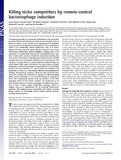Mostrar el registro sencillo del ítem
Killing niche competitors by remote-control bacteriophage induction
| dc.creator | Selva, Laura | es_ES |
| dc.creator | Viana, David | es_ES |
| dc.creator | Regev Yochay, Gili | es_ES |
| dc.creator | Trzcinski, Krzysztof | es_ES |
| dc.creator | Corpa, Juan Manuel | es_ES |
| dc.creator | Lasa Uzcudun, Íñigo | es_ES |
| dc.creator | Novick, Richard P. | es_ES |
| dc.creator | Penadés, José R. | es_ES |
| dc.date.accessioned | 2018-12-28T09:14:03Z | |
| dc.date.available | 2018-12-28T09:14:03Z | |
| dc.date.issued | 2009 | |
| dc.identifier.issn | 0027-8424 (Print) | |
| dc.identifier.issn | 1091-6490 (Electronic) | |
| dc.identifier.uri | https://hdl.handle.net/2454/31883 | |
| dc.description.abstract | A surprising example of interspecies competition is the production by certain bacteria of hydrogen peroxide at concentrations that are lethal for others. A case in point is the displacement of Staphylococcus aureus by Streptococcus pneumoniae in the nasopharynx, which is of considerable clinical significance. How it is accomplished, however, has been a great mystery, because H2O2 is a very well known disinfectant whose lethality is largely due to the production of hyperoxides through the abiological Fenton reaction. In this report, we have solved the mystery by showing that H2O2 at the concentrations typically produced by pneumococci kills lysogenic but not nonlysogenic staphylococci by inducing the SOS response. The SOS response, a stress response to DNA damage, not only invokes DNA repair mechanisms but also induces resident prophages, and the resulting lysis is responsible for H2O2 lethality. Because the vast majority of S. aureus strains are lysogenic, the production of H2O2 is a very widely effective antistaphylococcal strategy. Pneumococci, however, which are also commonly lysogenic and undergo SOS induction in response to DNA-damaging agents such as mitomycin C, are not SOS-induced on exposure to H2O2. This is apparently because they are resistant to the DNAdamaging effects of the Fenton reaction. The production of an SOS-inducing signal to activate prophages in neighboring organisms is thus a rather unique competitive strategy, which we suggest may be in widespread use for bacterial interference. However, this strategy has as a by-product the release of active phage, which can potentially spread mobile genetic elements carrying virulence genes. | en |
| dc.description.sponsorship | This work was supported by Comisión Interministerial de Ciencia y Tecnología Grants BIO2005-08399-C02-02, BIO2008-05284-C02-02, and BIO2008-00642-E/C; Cardenal Herrera-CEU University Grants PRCEUUCH25/ 08 and Copernicus program; and by Conselleria de Agricultura, Pesca i Alimentació (CAPiA), and from the Generalitat Valenciana (ACOMP07/258) (J.R.P.). L.S. and D.V. were supported by Cardenal Herrera-CEU University fellowships. | en |
| dc.format.extent | 5 p. | |
| dc.format.mimetype | application/pdf | en |
| dc.format.mimetype | application/zip | en |
| dc.language.iso | eng | en |
| dc.publisher | National Academy of Sciences | en |
| dc.relation.ispartof | PNAS, January 27, 2009 106 (4) 1234-1238 | en |
| dc.rights | © 2009 by The National Academy of Sciences of the USA | en |
| dc.subject | Hydrogen peroxide | en |
| dc.subject | SOS response | en |
| dc.subject | Staphylococcus aureus | en |
| dc.subject | Streptococcus pneumoniae | en |
| dc.subject | Bacterial interference | en |
| dc.title | Killing niche competitors by remote-control bacteriophage induction | en |
| dc.type | info:eu-repo/semantics/article | en |
| dc.type | Artículo / Artikulua | es |
| dc.contributor.department | IdAB. Instituto de Agrobiotecnología / Agrobioteknologiako Institutua | es |
| dc.rights.accessRights | info:eu-repo/semantics/openAccess | en |
| dc.rights.accessRights | Acceso abierto / Sarbide irekia | es |
| dc.identifier.doi | 10.1073/pnas.0809600106 | |
| dc.relation.publisherversion | https://doi.org/10.1073/pnas.0809600106 | |
| dc.type.version | info:eu-repo/semantics/publishedVersion | en |
| dc.type.version | Versión publicada / Argitaratu den bertsioa | es |


